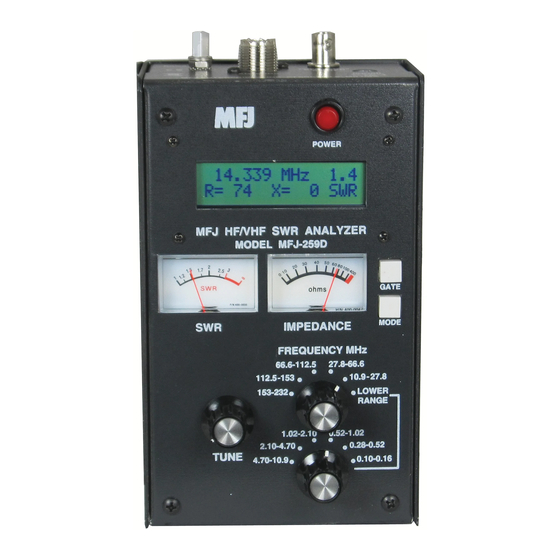
Table of Contents
Advertisement
Quick Links
Advertisement
Table of Contents

Summary of Contents for MFJ Enterprises MFJ-249D
-
Page 2: Table Of Contents
MFJ-249D Instruction Manual HF/VHF SWR Analyzer TABLE OF CONTENTS 1.0 INTRODUCTION..............................1 A Quick Word about Accuracy ......................1 Typical Uses ............................2 Frequency Range ..........................2 2.0 POWER SOURCES .............................. 2 External Power Supply ........................2 Using Internal Batteries ........................3 Using Rechargeable “AA”... -
Page 3: Introduction
However, the MFJ-249D minimizes this problem with careful pc layout and by using low-capacitance microwave-grade surface-mount components with virtually no lead length. -
Page 4: Typical Uses
Consult the table of contents for various applications. Frequency Range The MFJ-249D covers 0.10 to 0.16 and 0.28 to 230 MHz using a precision reduction-drive VFO tuning capacitor and two band switches. Bands of coverage are: Main Switch: 155-230 MHz 113-155 MHz... -
Page 5: Using Internal Batteries
2.1 mm The MFJ-249D has a recessed 2.1 mm power jack located on the top-right-hand side of the unit. It is labeled Power 13.8 VDC. The jack's outside barrel contact is negative and the center pin is positive. Inserting a power plug into the power jack automatically disables the internal batteries as a power source. -
Page 6: Power Saving" Mode (Sleep Mode)
IMPORTANT WARNING: Never Apply RF or any other external voltage to the Antenna port of this unit. The MFJ-249D uses zero bias detector diodes that may be damaged by external voltages. Read Section-2.0 before applying power! Incorrect supply voltages will also damage this unit. -
Page 7: Main Mode Descriptions
Section 3.2 (SWR, Impedance R&X). The MFJ-249D has three (3) Basic Operating Modes that are used for conducting a variety of measurements. If you tap (momentarily press) the Mode button, the analyzer steps to the next Mode selection. The three main modes and their opening screens are described in Section-3.3 below:... -
Page 8: Blinking "Voltage Low" Display Warning
A basic understanding of antenna theory and transmission line behavior will be helpful for making the best use of the data provided by your MFJ-249D. The ARRL Handbook and ARRL Antenna Book provide concise peer-reviewed explanations that should suffice for most applications. When it comes to the finer points of antenna design, there is (unfortunately) a fair amount of mis-information circulating on the web and over the airwaves. -
Page 9: Adjusting Simple Antennas
MFJ-249D Instruction Manual HF/VHF SWR Analyzer ADJUSTING SIMPLE ANTENNAS Most antennas are tuned for operating frequency by varying the element length -- and most homemade verticals and dipoles are very simple to adjust. Dipoles Because the dipole is a balanced antenna, it's always a good idea (and good engineering practice) to install a balun at the feed point. -
Page 10: Testing And Tuning Stubs And Transmission Lines
( like 1, 1-1/2, etc.). Connect the PL-259 to the "ANTENNA" connector of the MFJ-249D and adjust the line or stub by the following method. For critical stubs you may want to gradually trim the stub to frequency. -
Page 11: Adjusting Tuners
Adjusting Tuners The MFJ-249D can be used to adjust tuners. Connect the MFJ-249D "ANTENNA" connector to the tuner's 50 ohm input and the desired antenna to the normal tuner output. This connection can be made with a manual RF switch to facilitate rapid changeover. -
Page 12: Testing Rf Transformers
MFJ-249D. The other winding(s) of the transformer is then terminated with a low inductance resistor that is equal to the windings impedance. The MFJ-249D can then be swept through the desired transformer frequency range. The SWR and bandwidth of the RF transformer can be measured. -
Page 13: Measure Capacitance
F = MHz C = pF Resonant Frequency of Tuned Circuits The MFJ-249D can be used to measure the resonant frequency of tuned circuits by two methods. The first method involves placing a 50 ohm resistor in series with the MFJ-249D "ANTENNA" connector. -
Page 14: Testing Rf Chokes
TECHNICAL ASSISTANCE If you have any problem with your MFJ-249D, first check the appropriate section of this manual. If the manual does not reference your problem and the problem isn't solved by reading the manual, you may call MFJ Technical Service at 662-323-0549 or the MFJ Factory at 622-323-5869. - Page 15 MFJ Enterprises, Inc. at the time of warranty service. MFJ Enterprises, Inc. shall have the discretion to deny warranty without dated proof-of- purchase.
- Page 16 MFJ-989C VersaTuner V Instruction Manual...






Need help?
Do you have a question about the MFJ-249D and is the answer not in the manual?
Questions and answers